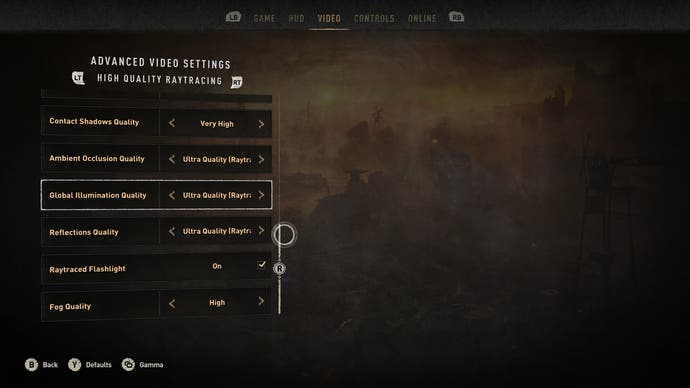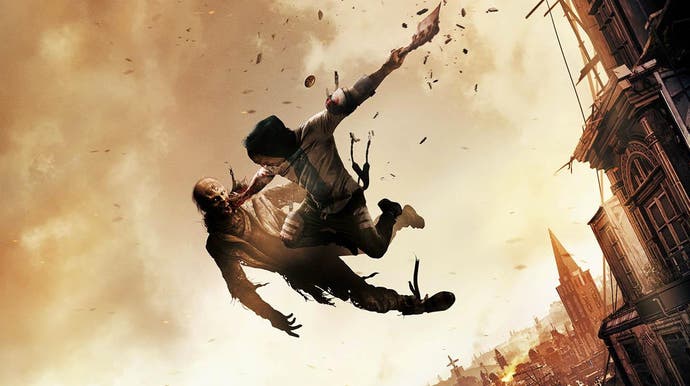Dying Light 2 PC is a graphics juggernaut that powers past the consoles
Our selection for the best settings across a range of hardware.
Dying Light 2 is a true graphics juggernaut that shines brightest on PC. Yes, it's a cross-gen title for sure, but one where Techland's C-Engine allows for scalability well beyond the limitations of the last-gen machines - and perhaps even their current-gen alternatives too. That's where high-end PC hardware comes to the fore, where Dying Light 2 deploys a range of hardware accelerated ray tracing features that radically transform the game, with only a small, limited sub-set of RT features ending up in the PS5 and Series X versions. Yes, you can play this game and get a good experience on consoles but the bottom line is this: the PC version goes much, much further.
Whether you're using an RT-enabled card or not, I've put together a series of optimised settings recommendations, but before we dig into this, it's important to put the console versions into context with the PC offering. Typically, console renditions of any given game use a grab-bag of varying PC-equivalent settings across the board - the developer's own optimised setting selection.
However, with Dying Light 2, it seems that Techland has chosen a different approach. The base last-gen consoles effectively run at something equivalent to PC at its low global preset. This rises to medium for the last-gen enhanced machines, and high for the PS5 and Xbox Series X. Expect some variance in specific settings here or there, but generally, that's the lie of the land.
It's when we go beyond the scope of the console versions that we see a PC version that clearly has high ambitions for the platform - but I was a touch disappointed to note that the range of the settings seemed somewhat more limited than its predecessor. This may well be down to the initial reaction to the first Dying Light's options - famously, its level of detail slider (even on minimum) presented higher draw distances than the console versions. However, many PC gamers chose to push the slider to the max, effectively killing performance. This time around, level of details sliders for geometry and shadow maps are absent.
This change has a few effects: firstly, Dying Light 2 by default looks a lot better than its predecessor because its graphical quality baseline is much higher. Secondly, this higher floor means that Dying light 2 scales worse than its predecessor on lower end hardware. Its graphics are better, meaning it requires more powerful GPU hardware, but areas of the graphics are now 'unscalable' that could have helped the lower end GPUs.
In terms of how Dying Light 2 scales beyond even PS5 and Xbox Series X versions, it's true that raster settings can go beyond the high territory occupied by the consoles, but you'll note that I've used these sparingly. In truth, the high setting seems almost like overkill in many scenarios. It's ray tracing where PC is transformative, principally with ray traced global illumination (RTGI), which accurately maps light bounce around the environments, completely transforming the scene. Shadows, ambient occlusion and reflections also benefit but for the best balance of performance and image quality, RTGI is the core focus.
When it comes to optimised settings overall, one set of recommendations isn't quite enough. What's clear is that this game is so demanding on the GPU that several iterations are required to maintain decent performance across a wide range of hardware. So, for lower-end graphics processors, I've come up with a range of settings that retain the lion's share of the game's visual splendour, but do produce some artefacts in select scenarios (for example, volumetric rendering quality). The mid-range alternative selection is very similar, but removes the more egregious trades I had to make to get a good experience - this is our recommended list of settings and should produce great performance on an RTX 2060 or better, even before you factor in DLSS - which Nvidia owners absolutely should tap into if they have the means.
This leaves us with the RT-optimised settings, which should deliver a locked 4K at 60 frames per second on an RTX 3080 using DLSS performance mode. Scaling down from there, less capable RTX cards should be capable of delivering good results at lower resolutions.
Typically, we like to target 60fps locked with optimised settings (or rather, a 60fps minimum for those running unlocked) but certainly on lower-end settings on something like a GTX 1060 or RX 580, the fact is that we're looking at a game that truly pushes graphics hardware - and some degree of latitude may be required. That comes out of the box if you're using a monitor with FreeSync or G-Sync support, but if you don't have variable refresh support, an alternative strategy to try is a custom 50Hz display resolution, which lowers your frame-rate target.

| Optimised Settings | Lower-End | Mid-Range | Optimised RT |
|---|---|---|---|
| Async Compute | On | On | On |
| Anti-Aliasing Quality | High | High | High |
| Motion Blur Quality | Low | Low | Low |
| Sun Shadows Quality | PCF | PCF | PCF |
| Contact Shadows Quality | Off | Ultra | Ultra |
| Ambient Occlusion Quality | Low | Low | Ultra RT |
| Global Illumination Quality | Low | High | Ultra RT |
| Reflection Quality | Low | Low | Low |
| Ray Traced Flashlight | Off | Off | Off |
| Volumetric Fog | Low | Medium | Medium |
As for performance in general, I'd rate Dying Light 2 fairly well. General performance is fluid, though there are some minor stutters - possibly on-the-fly shader compilation hiccups (I'd prefer these to be pre-cached before play). Secondly, it should be pointed out that the review code changed substantially during the review period and continues to change. DLSS looked great overall when I tested it, but did exhibit some strange bugs - both Nvidia and Techland are aware and we do expect this to be fixed. Beyond that, I do think the ray tracing effects need to be more scalable, because it's safe to say that the current set-up poses problems for AMD hardware. RT support is less performant than Nvidia, with FSR improving frame-rates but not to the dramatic degree required to offset the hit to performance - and that's before factoring in the hit to image quality.
With all of that said, as a PC enthusiast, I'm excited about this game - exactly because Techland has delivered a game that scales way beyond the current constraints of the consoles. In our article focusing on Xbox Series and PlayStation 5 versions, it was very much a case of having to choose between three very desirable features: high resolution, frame-rate or ray tracing features. The PC game allows users to combine all three, hardware-permitting - and even if you can't enjoy Dying Light 2 to the fullest extent possible with your current rig, the point is that the scalability is there to exploit future, hopefully more affordable hardware. And bearing in mind Techland's ambitious plans for the longevity of the game, that's good to see.


















